| [Related articles/posters: 089 119 049 ] |
All of three isomeric N-alkyl-5-nitropyrimidinones 1-3 have high electron deficiencies, and react with nucleophiles to afford polyfunctionalized systems.1-7
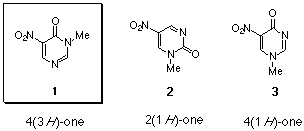
Although 3-methyl-5-nitropyrimidin-4(3H)-one (1) has multifunctionalities leading to various skeletons, no report dealing chemical behaviors of 1 was found. We paid attention to partial structures of pyrimidinone 1 such as masked nitroenamine, diformylamine and alpha-nitroformylacetic acid. In the present report, we would like to show that nitropyrimidinone 1 behaves as the precursor or synthetic equivalents of functionalized building blocks which are not readily available by utilizing the ring opening reaction or the ring transformations.
Nitropyrimidinone 1 was easily prepared as follows.
2-Thiouracil was reduced and methylated to give
3-methylpyrimidin-4(3H)-one.8 Nitration of the isolated
methylpyrimidinone with fuming HNO3 in 18 M H2SO4 at 110 deg.C
furnished nitropyrimidinone 1 in 47 % overall yield.
2) Synthesis of Nitropyrimidinone 1
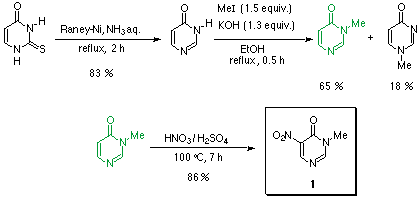
Nitroenamines9,10 are typical push-pull alkenes; this
structure means that these compounds can undergo such reactions as
electrophilic and nucleophilic addition-elimination, 1,3-dipolar cycloaddition
and reduction. Although functionalized nitroenamines are especially useful
synthetic intermediates for polyfunctionalized systems, only a few preparative
methods are known. The mainly employed synthetic method for them is the
condensation of nitroacetic acid derivatives with dialkoxymethylamines or
orthoformic esters. Since these starting materials are, however, not always
readily available, there is a demand for a more effective approach to
functionalized nitroenamines. From the point of view, nitropyrimidinones
1 could be regarded as being masked nitroenamines. In this section,
aminolysis of pyrimidinone 1 was studied.
To a solution of nitropyrimidinone in MeOH, PrNH2 was added and the mixture
heated for 3 hours. MeOH was removed, and the residue was recrystalized from
hexane to furnish N-methyl-2-nitro-3-propylaminopropenamide in 94 %
yield. The present reaction was applicable to other primary amines and NH3
leading to corresponding nitroenamines which had a N-methylcarbamoyl
group.
3) Syntheses of Functionalized Nitroenamines2
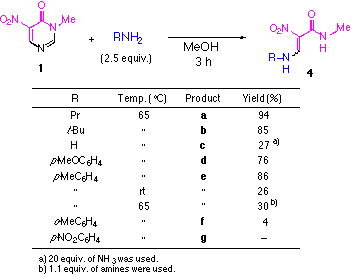
Synthetic value of prepared nitroenamines were also studied. As one of example, it was found that treatment of nitroenamine 4a (R = Pr) with enolate ion of ethyl acetoacetate furnished polysubstituted pyridone 5. It was considered that Michael type attack of the enolate anion occurred at the electrophilic site of enamine, and succeeding elimination of PrNH2 afforded the intermediate 6, which is converted into pyridone 5 by ring closure.

The estimated nucleophilic susceptibility11 revealed the 2-
and 6-positions being attacked readily by nucleophiles. This result means that
the C2-N1-C6 moiety of nitropyrimidinone 1 behaves as the synthetic
equivalent of diformylamine. Furthermore, the rest moiety eliminates as
the stable anion of N-methylnitroacetamide.12 Hence, we
considered that the ring transformation13 easily proceeds between
the 2- and 6-positions to afford various azaheterocyclic compounds.
4) Synthetic Equivalent of Activated Diformylamine

Diformylamine (diformamide) 7, the simplest secondary amide, has not been extensively used in organic synthesis due to its low reactivity. Since the carbonyl group of 7 reveals carbamoyl properties rather than formyl properties, nucleophilic substitution predominantly occurs.14-16 A unique example employing 7 as an aldehyde in an intramolecular Wittig reaction leading to a pyrrole derivative has been reported.17-18
To a solution of nitropyrimidinone 1 in EtOH, diethyl
acetonedicarboxylate and NEt3 were added, and heated. During the reaction,
3,5-bis(ethoxycarbonyl)pyridin-4(1H)-one 8a was precipitated.
Nitropyrimidinone 1 acted as the synthetic equivalent of activated
diformylamine 7 as we anticipated.
5) Ring Transformation of Pyrimidinone with Bidentate Enolates4

This reaction was applicable to 2,4,6-heptatrione and ethyl acetoacetate giving functionalized 4-pyridone 8b and 8c respectively. In the latter case, employment of sodium ethoxide was necessary.

The present reaction is considered to proceed as follows. Stepwise nucleophilic addition of bidentate ions to the 2- and 6-positions of pyrimidinone furnished bicyclic intermediate 9 or 9'. The elimination of anionic nitroacetamide from 9 gives ring transformed products, 3,5-bis(functionalized)pyridones 8.

The ring transformation of nitropyrimidinone with cyclohexanone in the
presence of NH3 readily proceeded to afford 4,5-tetramethylenepyrimidine
10a in good yield. In this reaction, it was also possible to use
enamines as the nucleophile instead of ketones.
In heterocycles having the pyrimidine skeleton, there are many functional
materials such as biologically active compounds. Pyrimidine rings have been
generally constructed by the condensation of a C-C-C and a N-C-N
units.19 In the present reaction, the condensation of a C-N-C and
a C-C-N units was involved. This type of general synthesis for pyrimidines has
not been reported to our knowledge.
6) Ring Transformation with Ketones in the Presence of
Ammonia1
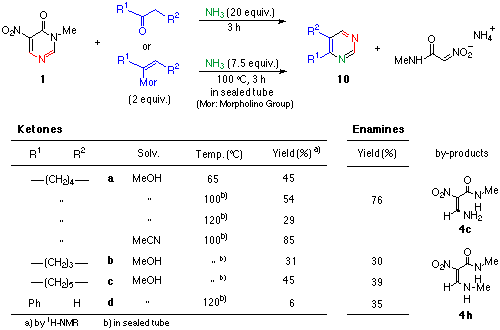
Although this reaction is novel preparative method for synthesis of 4,5-disubstituted pyrimidines, it requires severe reaction conditions and is applicable only to restricted substrates. In these cases, nitroenamines 4c and 4h were isolated as by-products. We attribute the restriction of this reaction to aminolysis as shown in section 3.
As mentioned in the previous section, the ring cleavage of pyrimidinone
1 with amines is considered to prevent progress of the ring
transformation. To avoid this aminolysis, less nucleophilic ammonium salts
were employed as the nitrogen source for the ring transformation.
A solution of nitropyrimidinone 1, acetophenone and NH4OAc in MeOH was
refluxed for 1 day. When the contents were cooled to room temperature, yellow
needles precipitated. The collected crystalline product was identified as
3-nitro-6-phenylpyridin-2(1H)-one 11d from its spectral and
analytical data. The filtrate was concentrated, and the residue was column
chromatographed to give 4-phenylpyrimidine 10d and a second crop of
pyridone 11d.
Usage of NH4OAc instead of NH3 in the ring transformation reaction afforded
pyrimidine 10d under more mild conditions and in a considerably improved
yield. Pyridone derivative 11d was also isolated as the other product
in moderate yield. Since 3-nitro-2-pyridone derivatives have recently
attracted attentions as anti-HIV drug intermediates, the present reaction would
be a useful method for construction of this skeleton.20-21 Although
this transformation proceeded even at room temperature, refluxing the mixture
brought about almost complete reaction after 1 day.
7) Ring Transformation with Ketones in the Presence of Ammonium
Salt3
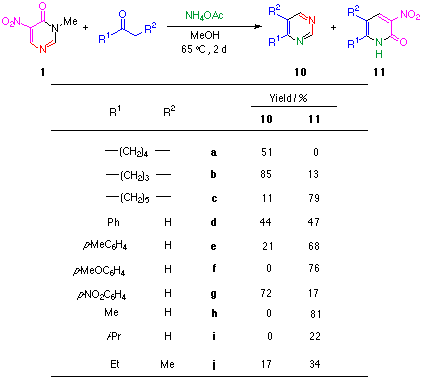
In this reaction, nitropyrimidinone 1 behaves as the activated diformylamine 7 and as the synthetic equivalent of alpha-nitroformylacetic acid 12.

The two products 10 and 11 were formed as follows.
Coordination of ammonium ion activates the carbonyl group of
pyrimidinone 1. The NH3 generated attacks the carbonyl group at the
4-position, and the enol of the ketone attacks the 6-position of 1 to
form adduct gives bicyclic intermediate 13, from which the amidine
derivative is eliminated to give pyridone 11. Pyrimidine 10 is
the resultant of the ring transformation at the 2- and the 6-position of 1
with liberation of nitroacetamide anion.
8) Plausible Mechanism
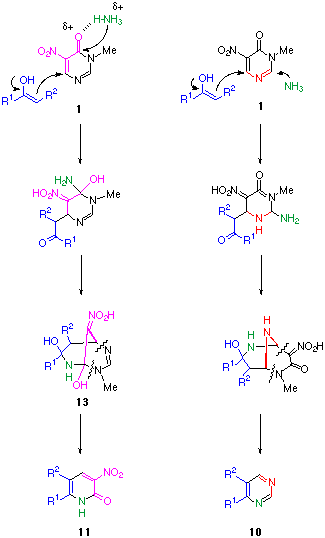
Nitropyrimidinone 1 reveals versatile reactivities.
Aminolysis utilizing the electron deficiency of 1 effectively afforded
functionalized nitroenamines which could not be readily available. Ring
transformations furnished 3,5-difunctionalized pyridin-4(1H)-ones,
4,5-disubstituted pyrimidines and 5,6-disubstituted
3-nitropyridin-2(1H)-ones. In these reactions, pyrimidinone 1
behaves as the activated diformylamine 7 or as the synthetic equivalent
of alpha-nitroformylacetic acid 12. Hence, nitropyrimidinone 1
would be a useful precursor of the functionalized building blocks which are
difficult to obtain by the alternative procedure.
9) Summary
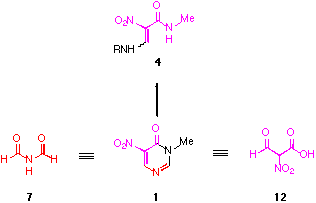
3-Methyl-5-nitropyrimidin-4(3H)-one 1
References and Notes
1 Nishiwaki, N.; Matsunaga, T.; Tohda, Y.; Ariga, M.
Heterocycles, 1994, 38, 249.
2 Nishiwaki, N.; Mizukawa, Y.; Ohta, M.; Terai, R.; Tohda, Y.; Ariga, M.
Heterocycl. Commun., 1996, 2, 21.
3 Nishiwaki, N.; Wang, H.-P.; Matsuo, K.; Tohda, Y.; Ariga, M. J. Chem.
Soc., Perkin Trans. 1, 1997, 2261.
3-Methyl-5-nitropyrimidin-4(3H)-one 1 and
1-Methyl-5-nitropyrimidin-2(1H)-one 2
4 Nishiwaki, N.; Tohda, Y.; Ariga, M. Synthesis, 1997,
1277.
1-Methyl-5-nitropyrimidin-2(1H)-one 2
5 Nishiwaki, N.; Tohda, Y.; Ariga, M. Bull. Chem. Soc. Jpn.,
1996, 69, 1997.
6 Fox, J. J.; Su, T.-L.; Stempel, L. M.; Watanabe, K. A. J. Org. Chem.,
1982, 47, 1081.
1-Methyl-5-nitropyrimidin-4(1H)-one 3
7 Nishiwaki, N.; Wakamura, E.; Nishida, Y.; Tohda, Y.; Ariga, M.
Heterocycl. Commun., 1996, 2, 129.
Above references (except 6) are available via the World Wide Web
(http://www.osaka-kyoiku.ac.jp/~rika/kagaku/paper.html ).
8 Bauer, L.; Wright, G. E.; Mikrut, B. A.; Bell, C. L. J. Heterocycl.
Chem., 1965, 2, 447.
9 Perekalin, V. V.; Lipina, E. S.; Berestovitskaya, V. M.; Efremov, D. A.
Nitroalkenes, Conjugated Nitro Compounds, Wiley, New York, 1994,
pp 210-231.
10 Rajappa, S. Tetrahedron, 1981, 37, 1453.
11 The estimation of nucleophilic susceptibility was conducted by the MOPAC
(PM3) molecular orbital calculation using CAChe system.
12 The ring transformation of similarly electron deficient
3,5-dinitropyridin-2(1H)-one involving the elimination of
N-methylnitroacetamide has been investigated; Tohda, Y.; Eiraku, M.;
Nakagawa, T.; Usami, Y.; Ariga, M.; Kawashima, T.; Tani, K.; Watanabe, H.;
Mori, Y. Bull. Chem. Soc. Jpn., 1990, 63, 2820.
13 Rusinov, V. L.; Chupakhin, O. N.; van der Plas, H. C. Heterocycles,
1995, 40, 441.
14 Kashima, C.; Arao, H.; Hibi S.; Omote, Y. Tetrahedron Lett., 1989,
30, 1561.
15 Allenstein, E.; Sille, F. Chem. Ber., 1978, 111, 921.
16 Allenstein, E.; Beyl, V. Chem. Ber., 1967, 100, 3551.
17 Flitsch, W.; Hampel, K.; Hohenhorst, M. Liebigs Ann. Chem.,
1990, 397.
18 Flitsch, W.; Hampel, K.; Hohenhorst, M. Tetrahedron Lett., 1987,
28, 4395.
19 Brown, D. J. in "Comprehensive Heterocyclic Chemistry", ed.
Katritzky, A. R., Pergamon Press, Oxford, 1984, Vol. 3, p. 57.
20 Meul, T. Patentschrift (Switz.), CH 682 562 A5/1993; (Chem.
Abstr., 1994, 120, 163 988).
21 Pomel, V.; Rovera, J. C.; Godard, A.; Marsais, F.; Quéguiner, G.
J. Heterocycl. Chem., 1996, 33, 1995.